We've seen a ton of top-of-the-line
gaming laptopsthat break the bank this year. But now we're finally seeing some premium rigs with slightly toned down specs that will give you strong performance and perhaps a bit less sticker shock.
Earlier this year, I reviewed the
Asus ROG Strix Scar 16, which was an absolute beast of a gaming laptop featuring an Intel Core Ultra 9 275HX processor and a GeForce RTX 5080 GPU. Now I have the chance to look at the ROG Strix G16, which is slightly lower on the laptop hierarchy than the ROG Strix Scar 16.
The ROG Strix G16 is the first laptop that we’ve reviewed with the AMD Ryzen 9955HX3D processor. The system also features a GeForce RTX 5070 Ti GPU, 32GB of DDR5-5600 memory, and a 1TB SSD. While the ROG Strix Scar 16 had a bank-breaking $3,299 price tag, the ROG Strix G16 is quite a bit cheaper at just $2,499. With those specs, we expected the system to be a standout performer in 1080p gaming. Instead, it was perfectly fine on the gaming front and instead made more of a statement in the productivity benchmarks.
Design of the Asus ROG Strix G16
At first glance, the ROG Strix G16 looks remarkably similar to the ROG Strix Scar 16, but a closer look reveals a host of differences. For one, the ROG Strix 16 lacks the configurable AniMe Vision system on the lid, composed of 810 LED lights. Instead, you’ll just find the ROG logo printed on the aluminum lid along with the slogan, “For Those Who Dare.”
The other significant change is at the bottom of the chassis, and it's my biggest disappointment with the design, after being spoiled by the ROG Strix Scar 16. The ROG Strix Scar G16 featured a bottom panel that locks in place with a simple sliding switch. You slide the switch to the left, pull the bottom panel towards you, and it lifts off in seconds.
The ROG Strix G16, on the other hand, features a more traditional bottom panel – one that is affixed with 11 Philips screws. Although it’s unlikely that even enthusiasts will frequently access the inside of this laptop, it’s disappointing to see that more members of the ROG laptop family have not adopted the quick-release system.
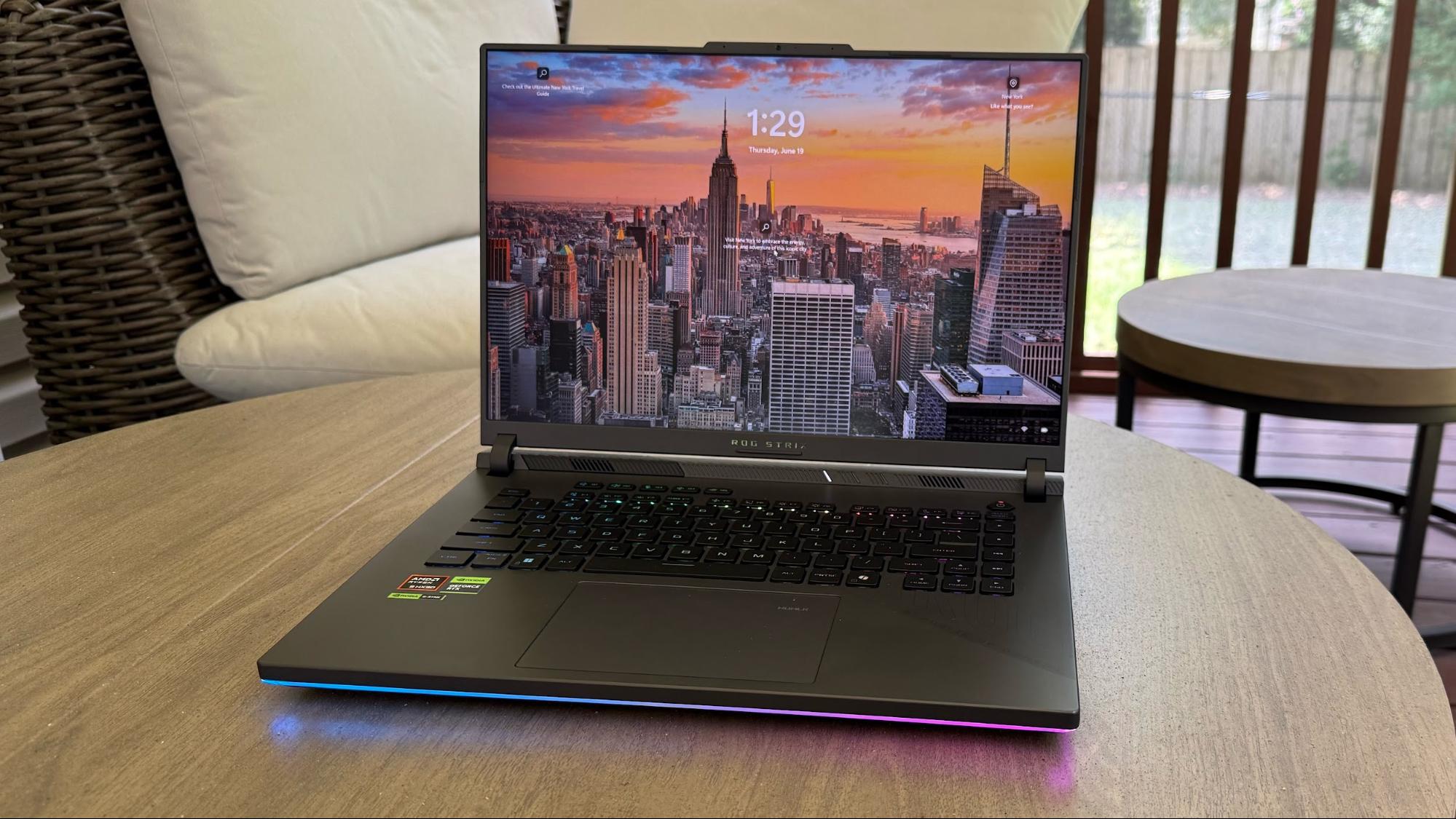
Another change from the Scar is a decrease in RGB lighting. The ROG Strix Scar 16 features an RGB light strip that runs the entire perimeter of the lower half of the chassis. However, the ROG Strix G16’s light strip only covers the front and a small portion of the left and right sides of the lower chassis. Asus had to trim costs somewhere, and this is an easy area to attack.
With that said, the Strix G16 regularly uses the rest of the Scar's design, including the high-quality plastic used for the rest of the chassis and an aluminum lid. While the keyboard deck is plastic, the finish is satiny-smooth. It just feels nice to run your fingers along the surface, and it’s equally pleasing for your palms as you type.
If you're looking for ports, there are only two USB 3.2 Type-A ports on the right side. The remainder of the ports are on the left side, where you’ll find the proprietary power connector, full-size GbE LAN port, an HDMI 2.1 port, two USB 4 Type-C ports, and a 3.5mm headphone jack.
The ROG Strix G16 measures 13.94 x 10.39 x 0.89 inches and weighs 5.51 pounds, which is on the lighter side in this class. For comparison, the ROG Strix Scar 16 is 13.94 x 10.55 x 0.90 inches and weighs 6.28 pounds, while the Razer Blade 16 is 13.98 x 9.86 x 0.69 inches and weighs 4.72 pounds. Rounding out the group is the 7.49-pound Alienware 16 Area-51 at 14.37 x 11.41 x 1.12 inches.
Asus ROG Strix G16 Specifications
Swipe to scroll horizontally
CPU | AMD Ryzen 9955HX3D |
Graphics | Nvidia GeForce RTX 5070 Ti (12GB GDDR7, 1,500 MHz Boost Clock + 50 MHz OC, 115W + 25W Dynamic Boost) |
Memory | 32GB DDR5-5600 (2x 16GB) |
Storage | 1TB PCIe 4.0 NVMe M.2 SSD |
Display | 16-inch, 2560x1600, 240 Hz, 16:10 |
Networking | MediaTek Wi-Fi 6E (MT7922), Bluetooth 5.3 |
Ports | 2x USB 4 Type-C, 3x USB 3.2 Type-A Gen 2, 1x HDMI 2.1, 3.5mm headphone jack, Gigabit Ethernet |
Camera | 1080p IR webcam |
Battery | 90 Whr |
Power Adapter | 280 W |
Operating System | Windows 11 Home |
Dimensions (WxDxH) | 13.94 x 10.39 x 0.89 inches |
Weight | 5.51 pounds |
Price (as configured) | $2,499.00 |
Gaming and Graphics on the Asus ROG Strix G16
The ROG Strix G16 is the first laptop that we’ve laid hands on that features AMD’s new Ryzen 9955HX3D processor, so we were eager to see how it would perform against similarly stout systems. AMD touts the 9955HX3D as the “world’s fastest mobile gaming processor,” in part due to its generous 128MB of L3 cache, 16 cores, and 5.4 GHz max boost clock, so we were expecting strong 1080p performance. Our review unit paired the processor with 32GB of DDR5-5600 memory (two 16GB modules) and an Nvidia GeForce RTX 5070 Ti GPU with 12GB of GDDR6 memory. Performance was fine, but not class-leading, even at FHD.
For comparison, the ROG Strix Scar 16 and Alienware 16 Area-51 use a Core Ultra 9 275HX and RTX 5080 (175W), while the Blade 16 runs a Ryzen AI 9 HX 370 with an RTX 5090 (160W). Those more powerful GPUs should deliver stronger performance at resolutions above 1080p.
I played an hour or so of Indiana Jones and the Great Circle on the ROG Strix G16 at the native resolution of 2560 x 1600. I maxed out at around 100 frames per second (fps) in most situations at native resolution with global graphics settings set to Ultra when plugged in. Unplugged, performance was capped at 60 fps.
Moving to our standard gaming benchmark suite, we started with Shadow of the Tomb Raider (Highest settings). The ROG Strix G16 was up against 175W RTX 5080s and an RTX 5090, so its last-place finish was expected. However, it still managed a commendable 151 fps at 1080p and 92 fps at 1600p. If you’re planning to play the game at native resolution, the Blade 16 outpaced all others in the field with 161 fps at 1600p.
Cyberpunk 2077 (Ray Tracing Ultra settings) is a resource-intensive game, and it can humble even the most potent graphics cards. The ROG Strix G16 again pulled up the rear of the field, but the delta was much smaller this time, as it managed 54 fps at 1080p and 29 fps at 1600p. The Blade 16 was again the standout in the group, delivering 66 fps at 1080p and 43 fps at 1600p.
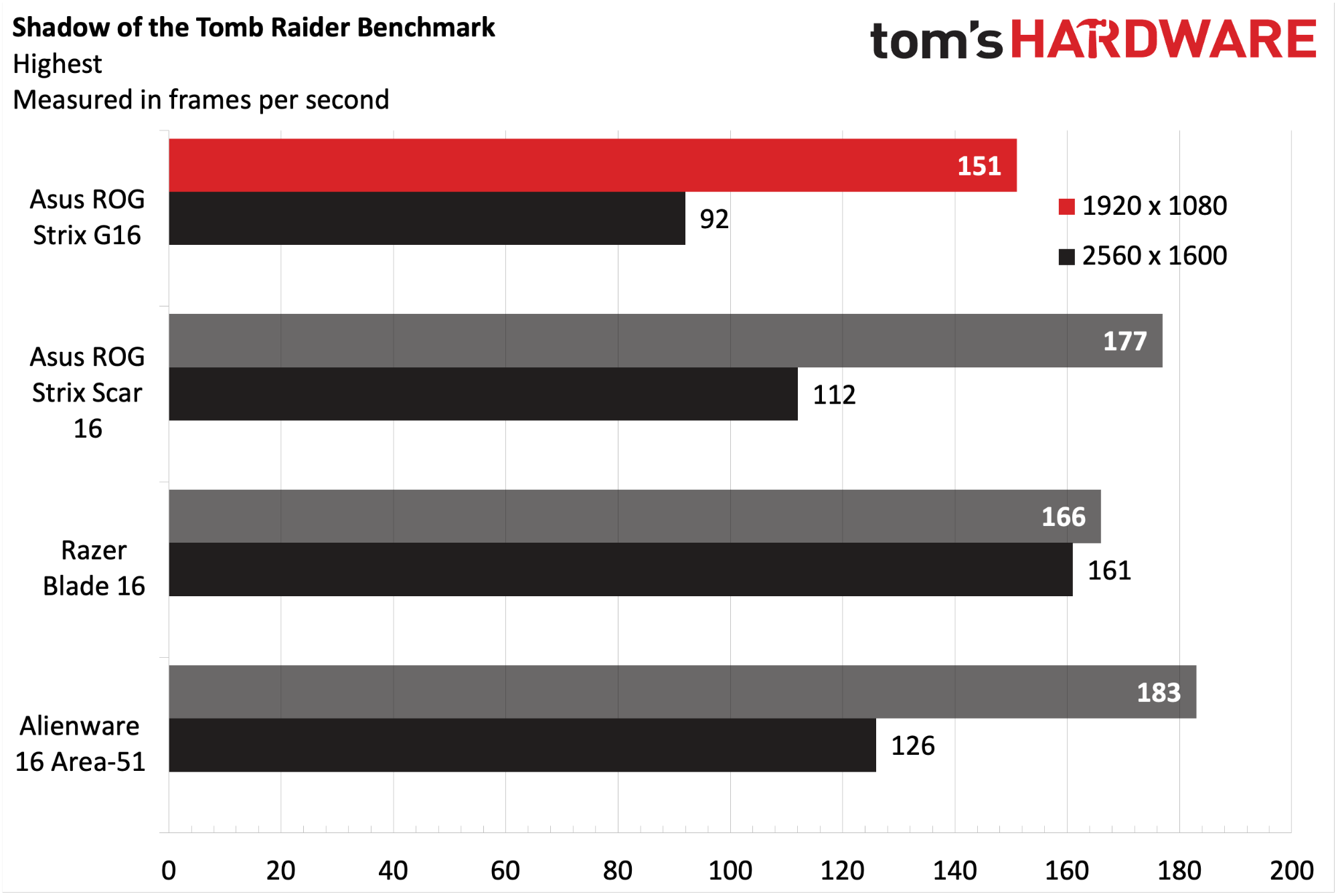
The Ryzen 9955HX3D was able to flex its gaming might in Far Cry 6 (Ultra settings), as the ROG Strix G16 shot to the leaderboard with 143 fps at 1080p, maintaining a 20+ fps advantage over the Alienware 16 Area-51. Its performance at 1600p fell to third place at 102 fps, but it was still within striking distance of the Alienware 16 Area-51’s 106 fps.
Red Dead Redemption 2 (Medium settings) has proven to be a performance challenge for RTX 50 series laptops. From failure to run to other oddities, the situation has only recently become more palatable for gamers playing this highly popular game. The ROG Strix G16 achieved 70 fps at 1080p and 52 fps at 1600p. For comparison, the Alienware 16 Area-51 torched all competitors with 117 fps and 84 fps at 1080p and 1600p, respectively.
Finally, Borderlands 3 (Badass settings) saw the ROG Strix G16 try to hang with the RTX 5080-equipped ROG Strix Scar 16 and Alienware 16 Area-51. Although it put up a good fight, 143 fps at 1080p and 97 fps at 1600p was all that the RTX 5070 Ti could muster.
We use Metro Exodus for our laptop stress testing, and the laptop averaged 101.5 fps over 15 runs. During the test, the Zen 5 cores averaged 3.02 GHz, while the CPU package measured 73.8 degrees Celsius. The GPU ran at an average of 2.19 GHz at a temperature of 78.7 C.
Productivity Performance on the Asus ROG Strix G16
The Ryzen 9955HX3D is no slouch in terms of performance, after all, it’s based on desktop-class Zen 5 silicon (the Ryzen 9 9950X3D, to be exact). Combined with 32GB of DDR5-5600 memory and a fast 1 TB Micron PCIe 4.0 SSD, the ROG Strix G16 is a strong contender when it comes to productivity tasks, perhaps even more so than in gaming
In the Geekbench 6 synthetic CPU benchmark, the ROG Strix G16 shot to the head of the class in both the single-core (3,205) and multi-core (20,113) tests. The next-closest competitor was the Alienware 16 Area-51, which came in at 3,097 and 19,822, respectively.
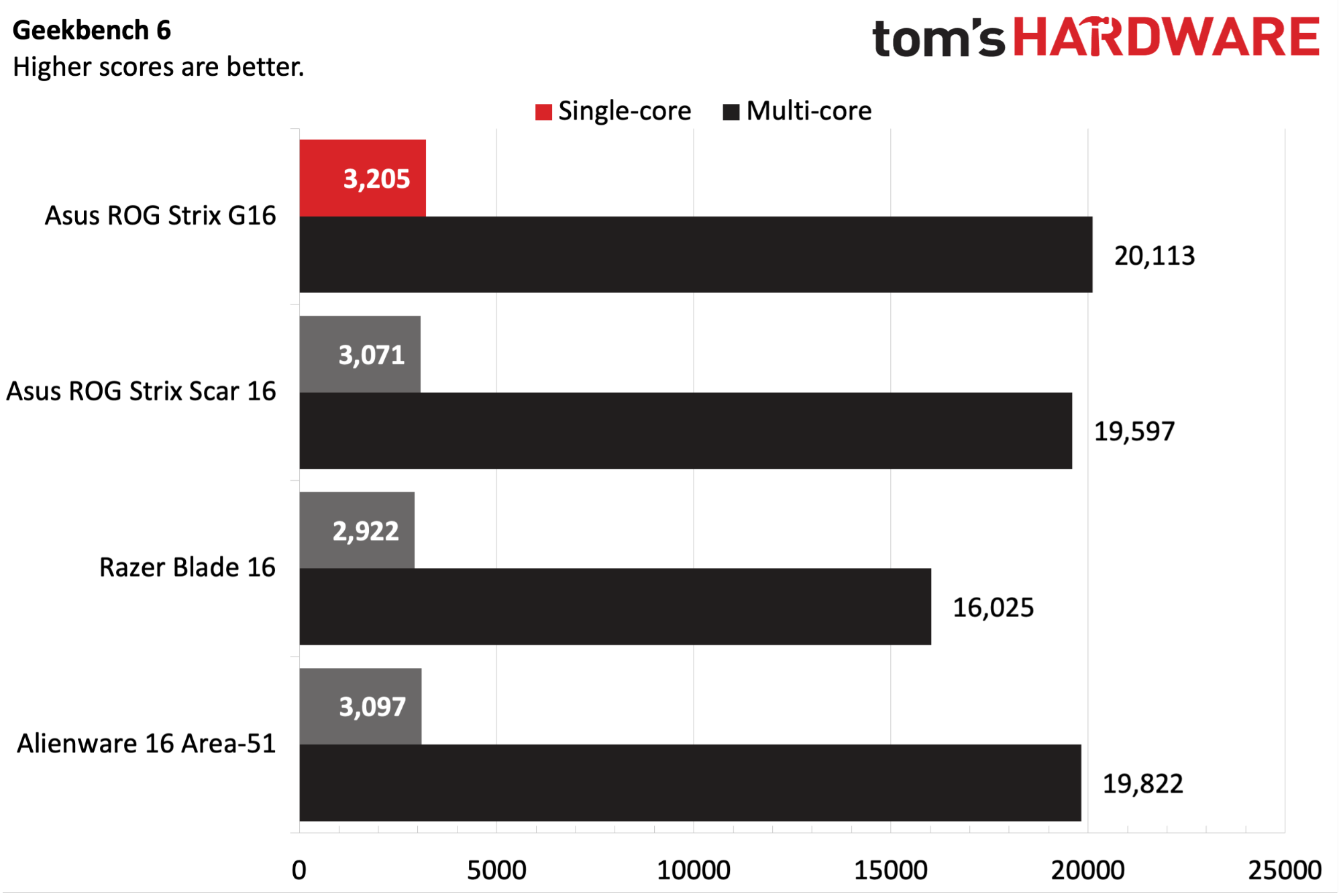
A similar story unfolded in our storage benchmark, where we copied 25 GB of mixed media. The ROG Strix G16 again took the top spot with a transfer rate of 1,903.64 MBps. This put it slightly ahead of its sibling, the ROG Strix Scar 16, which registered 1,841.40 MBps.
The winning streak came to an end with the Handbrake test, where we transcode a 4K video file to 1080p. Here, the Alienware 16 Area-51 completed the task in 1 minute and 58 seconds. The ROG Strix G16 was 16 seconds behind, finishing in 2 minutes and 14 seconds.
Display Performance on the Asus ROG Strix G16
WQXGA (2560 x 1600) is quickly becoming a popular resolution for gaming laptops, and Asus is happy to oblige with the ROG Strix G16. In addition, Asus takes it one step further, as the 16-inch panel features a 240 Hz refresh rate.
Our instrumented tests showed that the ROG Strix G16 largely mirrored the performance of the ROG Strix Scar 16 (well, within a few percentage points). The laptop’s IPS panel covered 79.7 percent of DCI-P3 and 112.5 percent of sRGB gamuts by volume. It’s likely that most folks won’t be using the ROG Strix G16 for color-critical creative work, but I found color reproduction to be satisfying to my eyes.
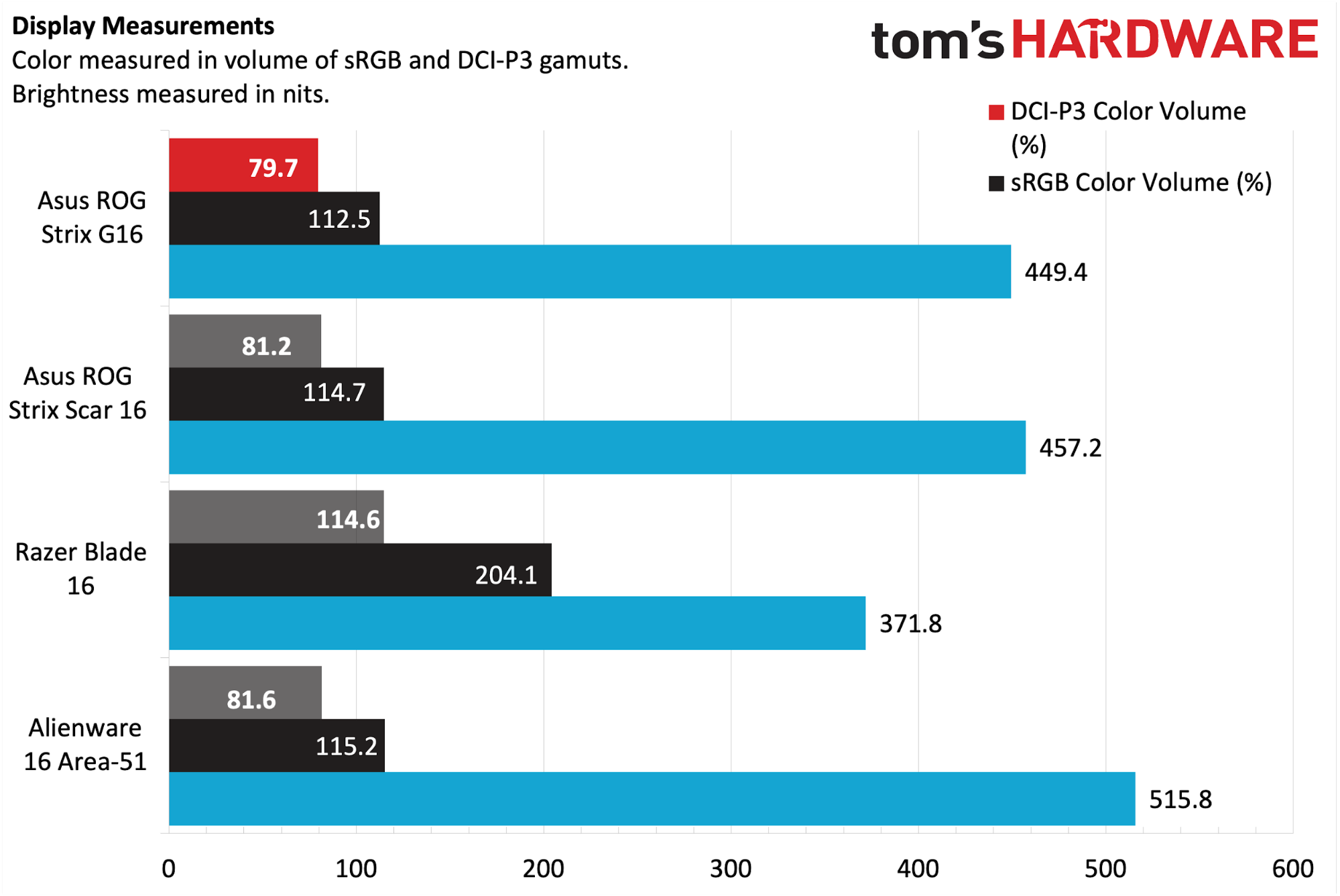
I played Forza Horizon 5, Cyberpunk 2077, and Indiana Jones and the Great Circle extensively on the ROG Strix G16 and was never wanting for more color. From the metallic undertones and realistic light blooming effects of Cyberpunk 2077, to the lush green environments of Indiana Jones, to the vibrant and highly reflective paint finishes on cars in Forza, I was deeply impressed with the overall color output.
Brightness was also a strong point for the ROG Strix G16, as its panel managed 449.4 nits. Given the anti-glare coating on the screen, I was able to tone down the brightness to about 50 percent and still enjoy reflection-free gaming (I often must bump the brightness up a bit to minimize light reflections on glossy laptop display panels in my home office).
Keyboard and Touchpad on the Asus ROG Strix G16
Asus has equipped the ROG Strix G16 with a full-size keyboard featuring per-key RGB lighting and Aura Sync technology. The keycap dish is 0.15 mm, and each key offers 1.9 mm of travel. In addition to the usual allotment of keys that you’ll find on a laptop keyboard, Asus also provides dedicated hotkeys, labeled M1 through M5. By default, the keys control everything from volume and mic mute to launching the Armoury Crate utility. However, all five keys are programmable within Armoury Crate to launch specific apps or as a macro.
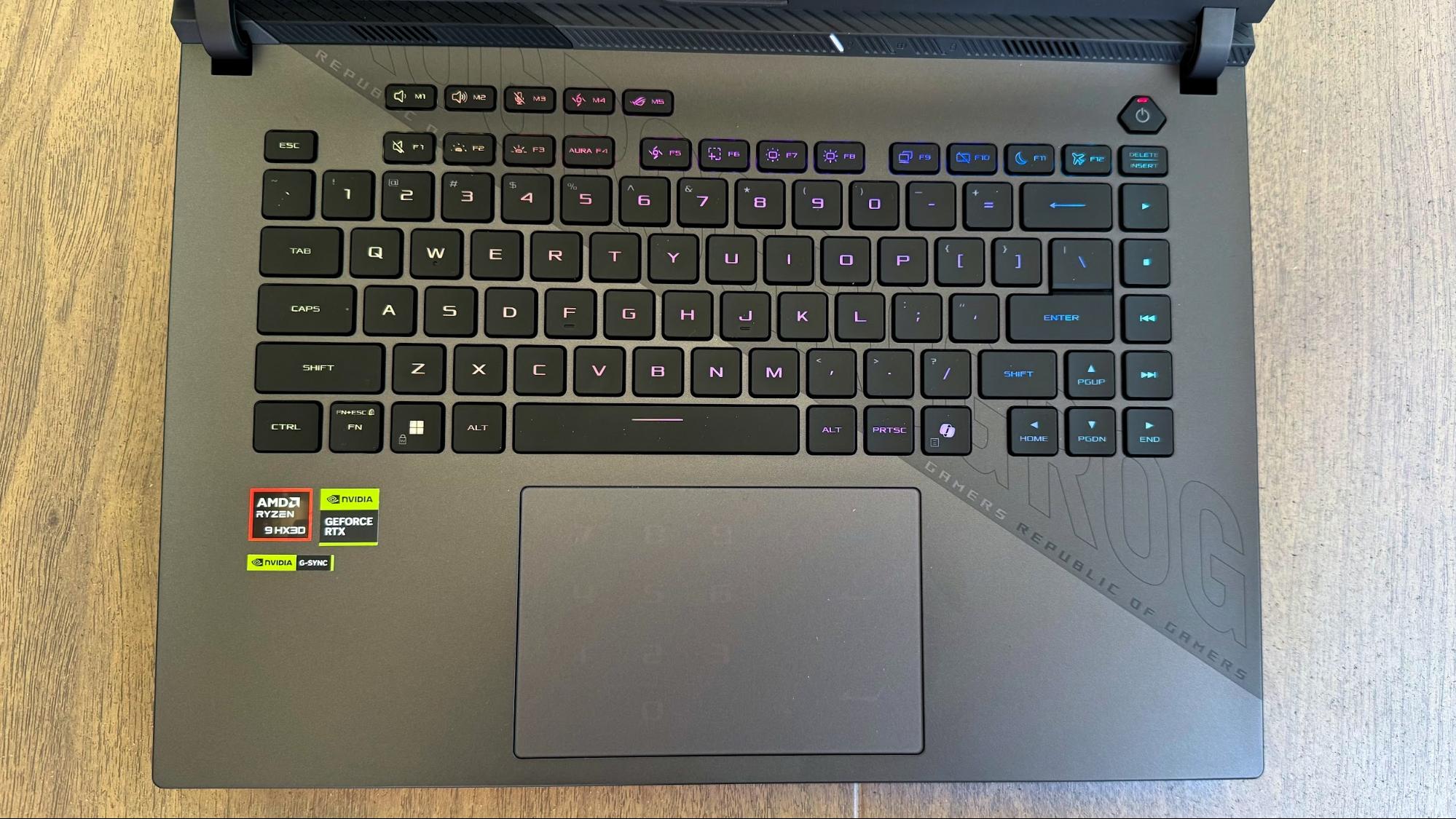
My go-to site for typing tests is keyhero.com, and I managed 92 words per minute with 98 percent accuracy, which was roughly in line with what I achieved on the ROG Strix Scar 16. As for the touchpad, it is large with a smooth surface and a very “clicky” response.
I’m a sucker for number pads on laptops, as I find them useful for quick number entries, especially when working in Microsoft Excel. The ROG Strix G16 doesn’t have a physical number pad, but it has the next best thing: its virtual NumberPad. The NumberPad is invoked by tapping NUMLK on the touchpad, which then illuminates the number pad. I really like Asus’ solution, as it allows for a more comfortable keyboard layout without the keys being cramped (which is often the case with a physical number pad off to the side).
Audio on the Asus ROG Strix G16
Despite the relatively large size of our review unit, Asus only includes two speakers. Both are mounted near the front of the chassis, under the palm rest. (If you look at the interior shots below, you will see that they flank the battery.)
The speakers are sufficient to easily overpower the relatively low sound output coming from the three internal fans. With volume set to 40 percent, I played Janet Jackson’s “Rhythm Nation,” only to be disappointed by the flat audio quality. Don’t get me wrong, even at 40 percent, the audio output was enough to fill my large home office. However, the vocals sounded lifeless, the drums lacked kick, and I felt overall unfulfilled while listening to the early 90s classic.
It was a similar experience for games, as the lifeless audio detracted somewhat from the overall ambiance of playing games. So while the speakers can be used to mask the fans, most true enthusiasts will undoubtedly opt for the best gaming headsets for an optimal gaming experience.
Upgradeability on the Asus ROG Strix G16
After coming from the one-button, slide-and-lift bottom panel removal of the ROG Strix Scar 16, access on the ROG Strix G16 was disappointing. Asus has spoiled me for life with the easy-to-use and intuitive solution. The ROG Strix G16, on the other hand, features a more traditional approach, with a bottom panel affixed with 11 Philips screws. With the screws removed, all it takes is a carefully placed fingernail in the front corner of the panel to begin the process of prying the panel off.
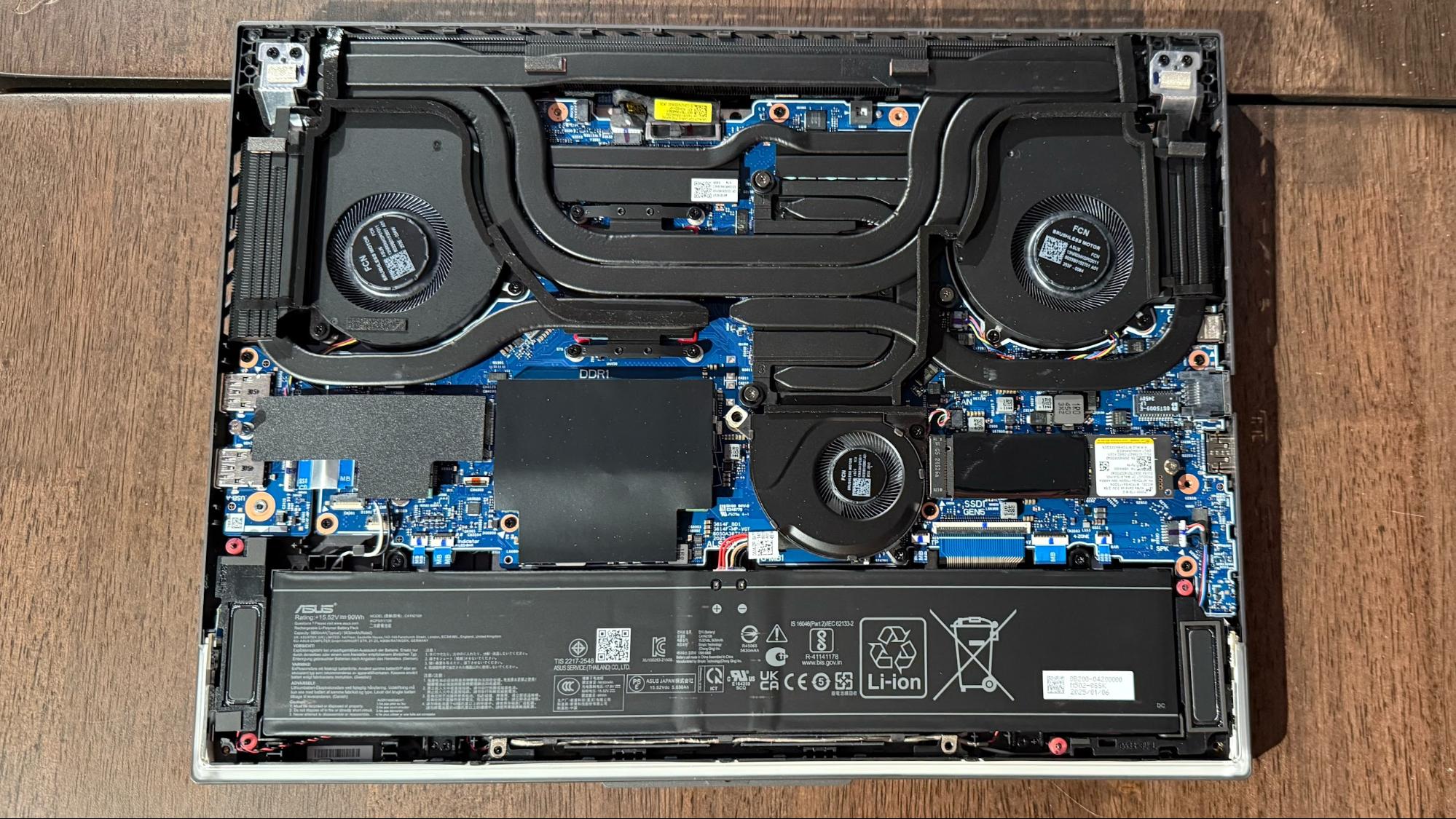
Once inside, you’ll find that the ROG Strix G16 is pretty accommodating to future upgrades. There are two M.2 2280 slots for PCIe 4.0 SSDs, one of which is already populated by a Micron 1TB SSD. The second M.2 slot for storage hides under a shield on the left side of the chassis. Also lurking under that plastic shield is a third M.2 slot for a Mediatek Wi-Fi 6E card. It would be trivial to replace it with a Wi-Fi 7 adapter for a speed boost.
Towards the center of the chassis, you’ll notice another large plastic shield covering the two SO-DIMM slots. 16 GB DDR5-5600 modules occupied both slots on our review unit.
Battery Life on the Asus ROG Strix G16
Our review unit came with a 90 Whr battery installed. To test its endurance, we ran our automated benchmark, which simulates browsing the web, streaming videos, and running OpenGL tests with the display panel brightness locked at 150 nits.
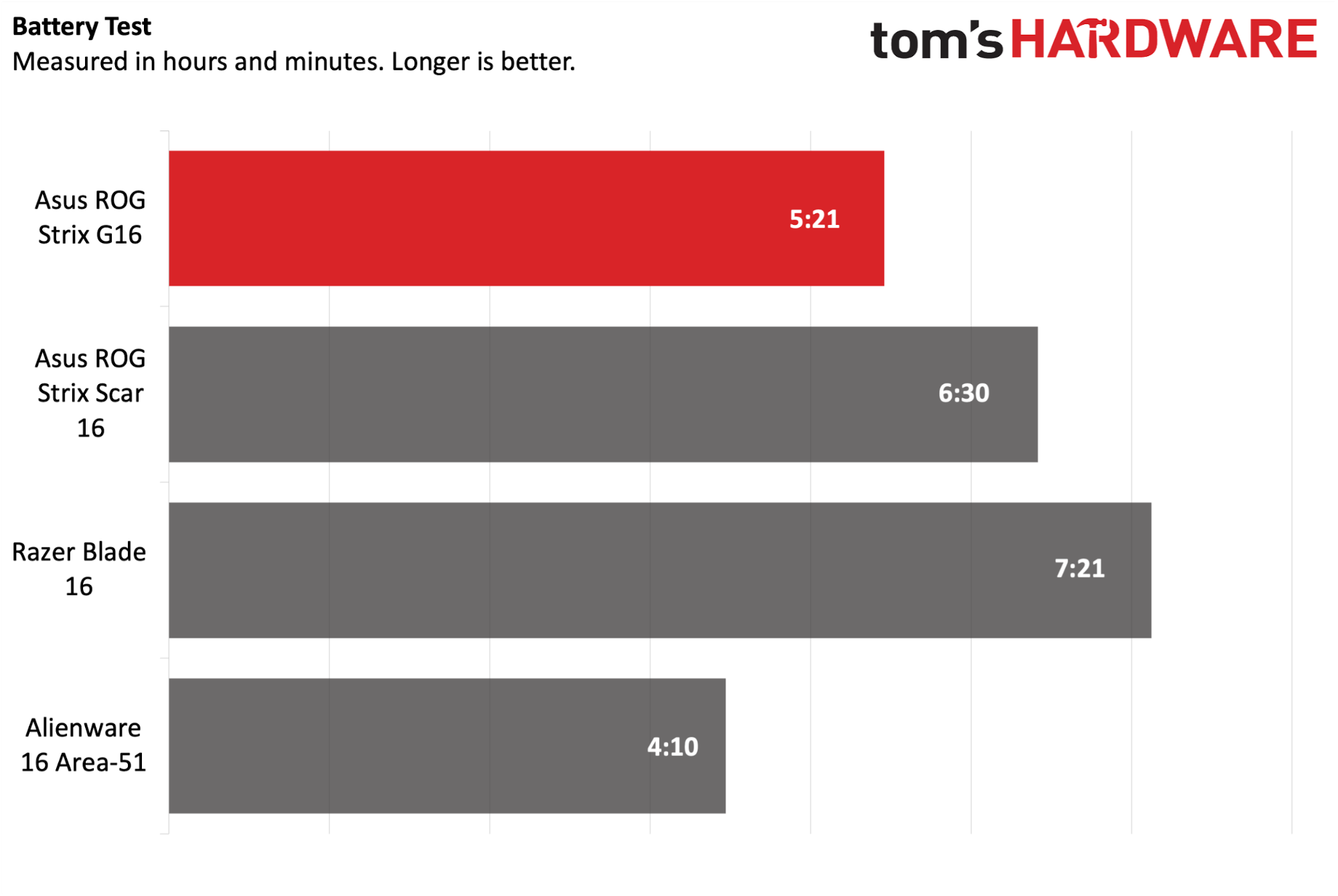
Under these conditions, the ROG Strix G16, which used Nvidia Advanced Optimus, fizzled out after 5 hours and 21 minutes. The Blade 16, which uses a Ryzen AI 9 HX 370 without the 3D cache, lasted exactly two hours longer (7:21).
Heat on the Asus ROG Strix G16
The ROG Strix G16 features three internal fans, which do a good job of ridding the system of heat. I say that because even when benchmarking and running games at full tilt, the fan noise remained relatively low. I was always aware that the fans were running, but they didn't ruin my immersion during gaming. If you find the sound to be objectionable, you can always opt for a pair of the best gaming headsets.

When running the Metro Exodus stress test, the touchpad measured 75.4 degrees Fahrenheit, while the keyboard hit 92.8 F between the G and H keys. However, the hottest part of the laptop was near the F4 key, which registered 127 F.
Webcam on the Asus ROG Strix G16
Asus includes a basic 1080p webcam on the ROG Strix G16. 1080p is essentially the baseline for modern laptops, as most have transitioned from lower-resolution 720p units. With that said, image quality was passable, although not particularly good. Like the pricier ROG Strix Scar 16, the ROG Strix G16 exhibited grainy photos and video. My skin looked a little washed out in the video footage, and a slightly aggressive smoothing algorithm was implemented, which made my skin seem unnatural.
Software and Warranty on the Asus ROG Strix G16
The ROG Strix G16 comes preinstalled with a few third-party apps from the factory. One of them is Armoury Crate, which is a utility for monitoring system vitals and adjusting performance profiles. It can also be used to configure RGB effects for the chassis and keyboard (with Aura Sync). There's also MyAsus, a separate app for registering your laptop, performing system upgrades, and running hardware diagnostics. Other utilities include Aura Creator (for creating RGB profiles) and CapCut (a short-form video and graphics editing app).
The last preinstalled app is McAfee antivirus, which I hate with a passion. Luckily, you can easily kick the app to the curb by uninstalling it.
The ROG Strix G16 comes with a one-year warranty from the manufacturer.
Asus ROG Strix G16 Configurations
The AMD processor-equipped ROG Strix G16 (G614) is available in three configurations. Our review unit is equipped with a Ryzen 9955HX3D processor, 32GB of DDR5-5600 memory, a 1TB SSD, a 16-inch 240 Hz WQXGA IPS display, and a GeForce RTX 5070 Ti GPU. The unit carries an MSRP of $2,499.99.
Asus also offers a configuration with a Ryzen 9 8940HX, 16GB of DDR5-5600 RAM, a 1TB SSD, a 165 Hz FHD+ display, and an RTX 5070 Ti. The last configuration swaps the 16GB of DDR5-5600 for 32GB and the RTX 5070 Ti for a less performant RTX 5070.
Bottom Line
The Asus ROG Strix G16 dials back the GPU performance a notch compared to its more expensive sibling due to the use of an RTX 5070 Ti instead of the RTX 5080, however, the Ryzen 9955HX3D holds its own in productivity tasks. Best of all, the ROG Strix G16 comes in with an $800 lower price tag than the ROG Strix Scar 16 for cost-conscious enthusiasts.
You do give up a bit for that $800, including PCIe 5.0 support, the trick toolless bottom panel, and a reduction in the amount of RGB effects. However, I think that it’s a fair exchange to reach a broader segment of the market.

 4 months ago
63
4 months ago
63
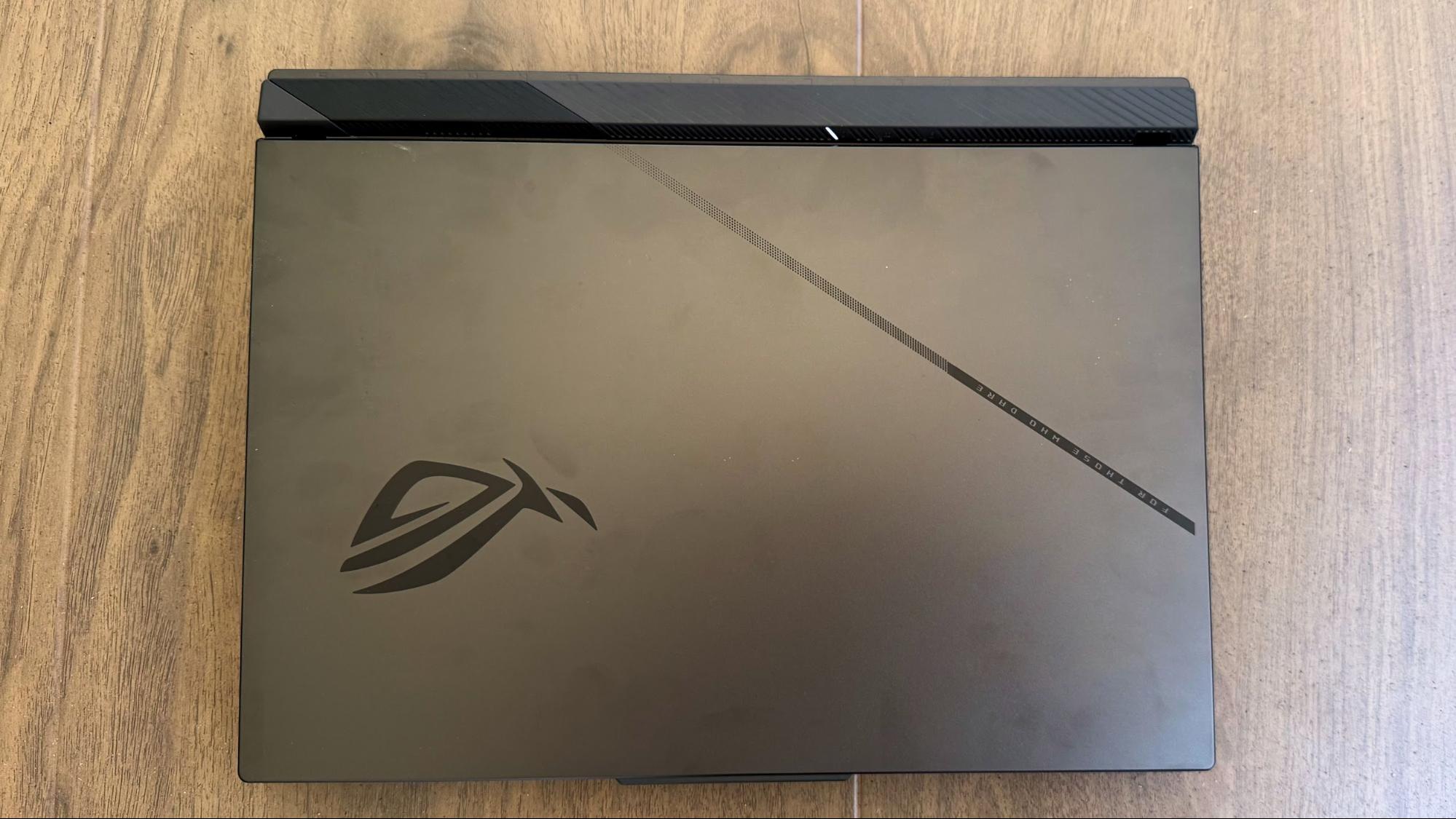
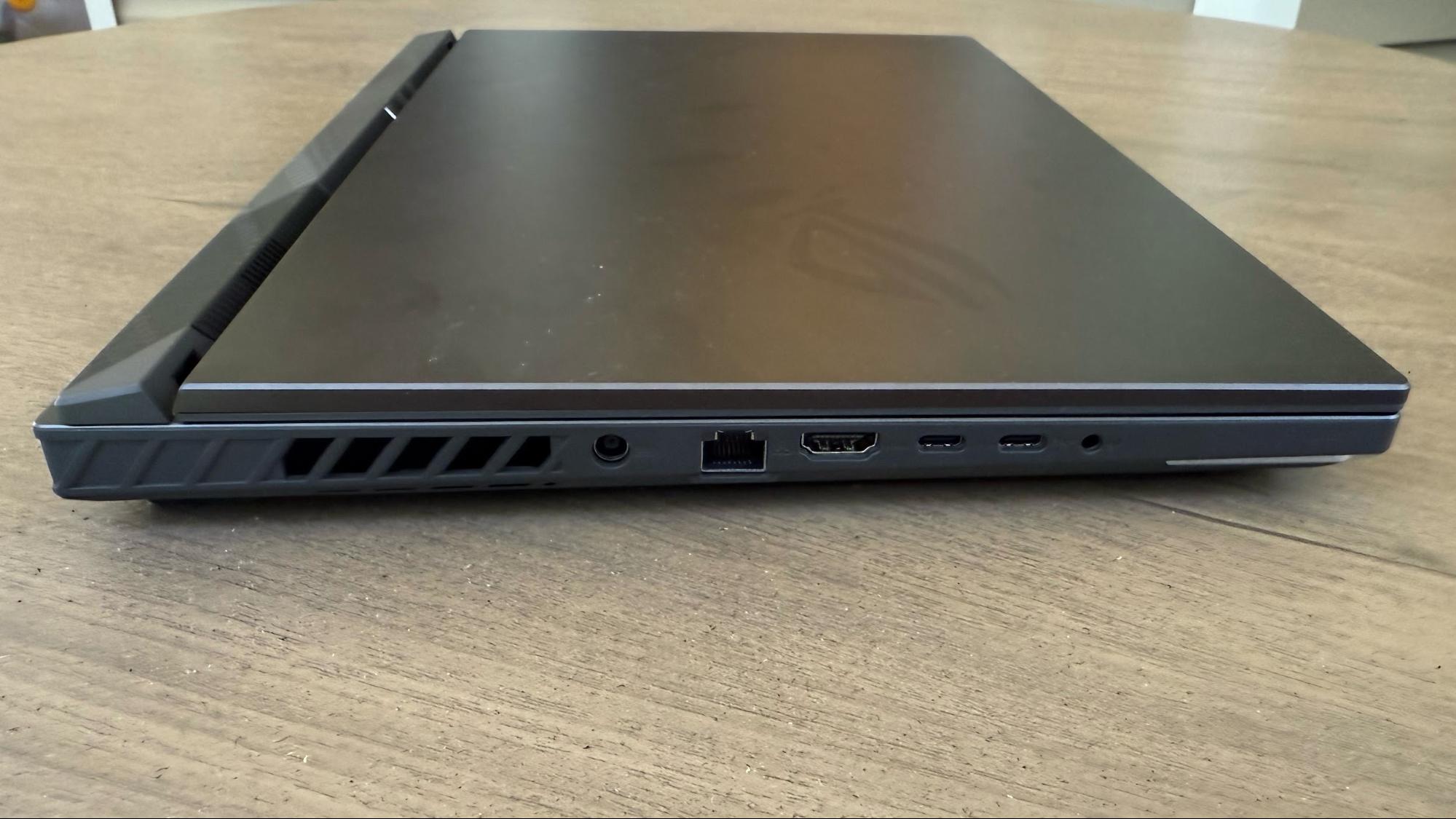
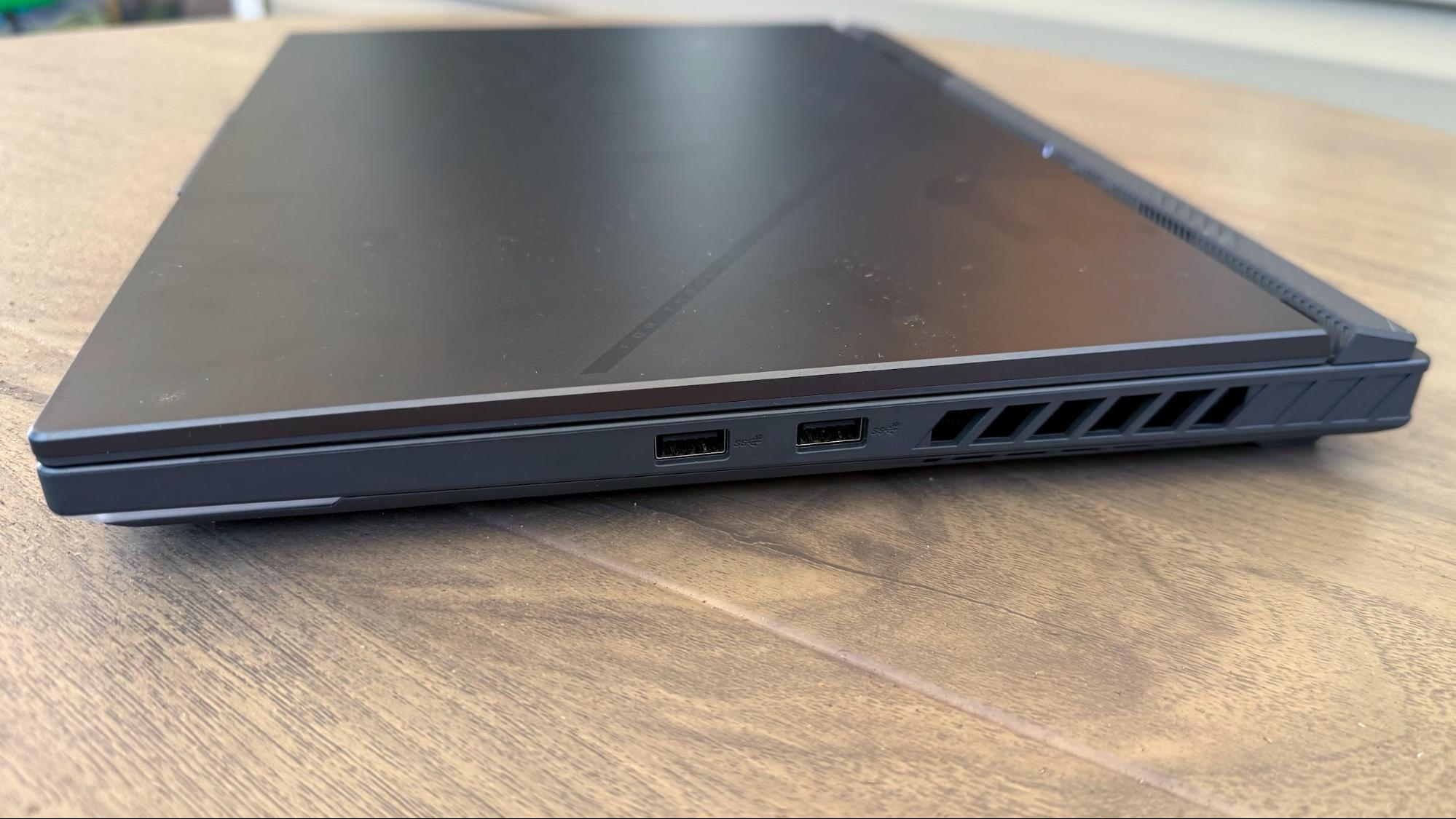
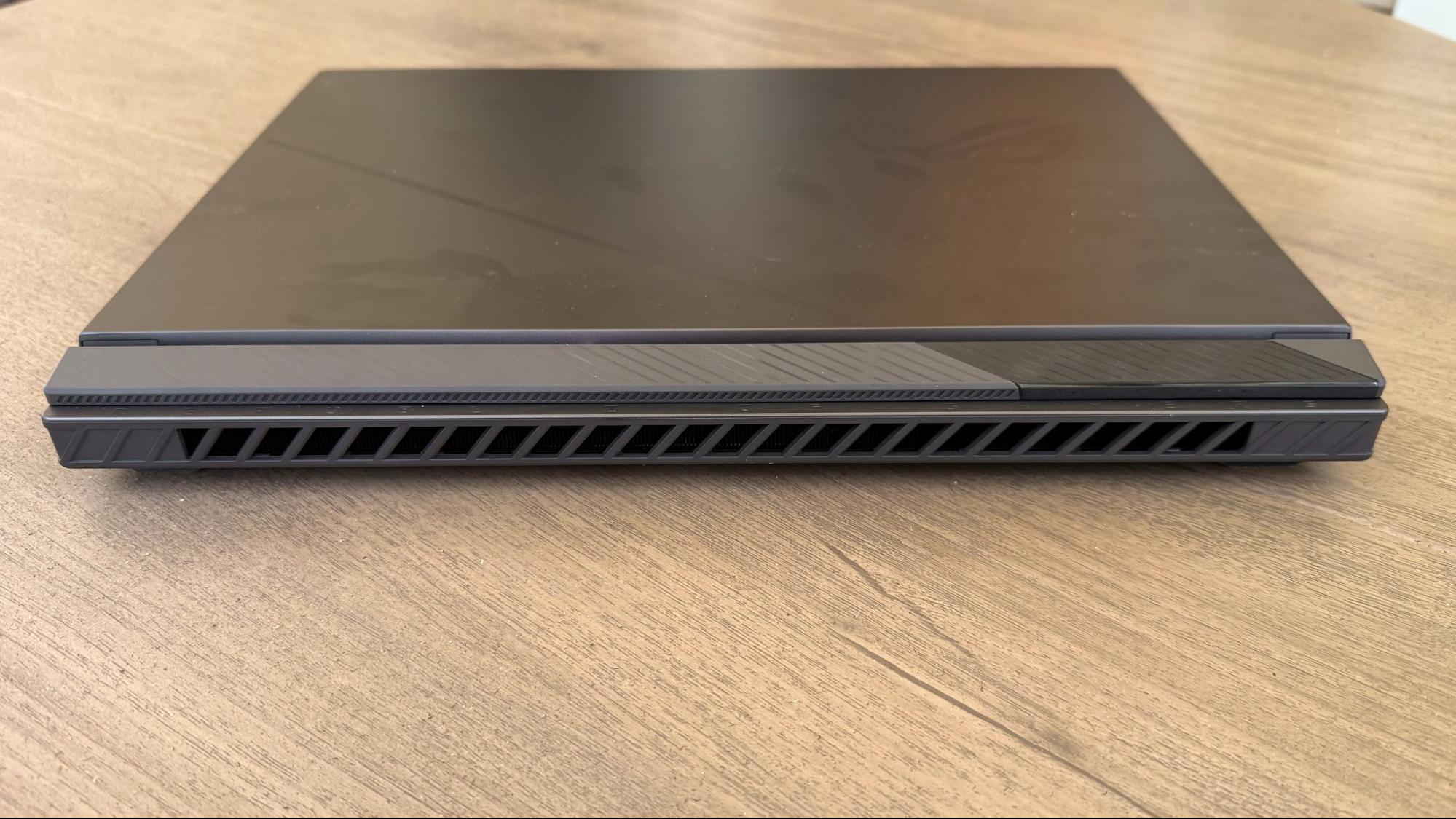
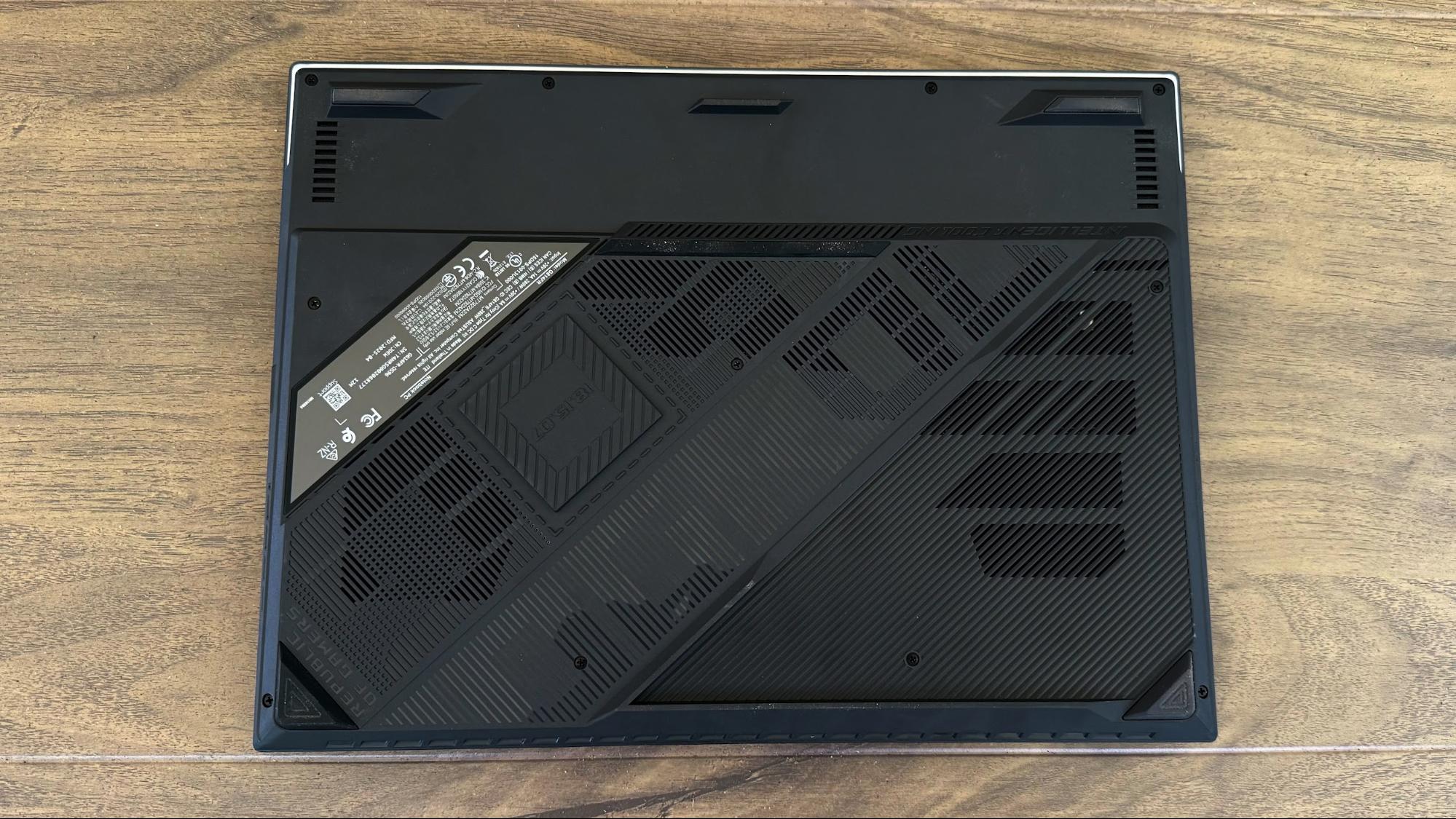
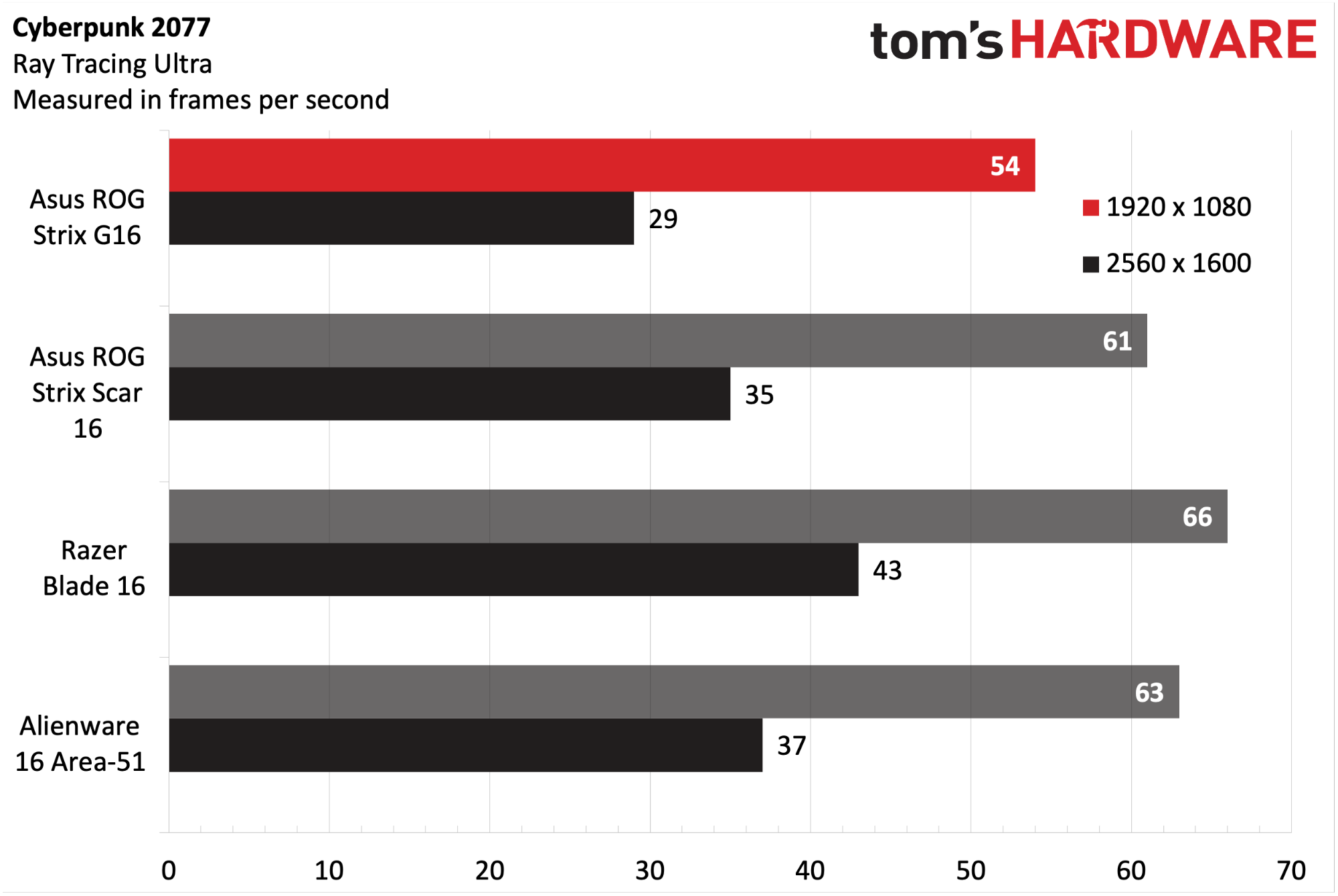
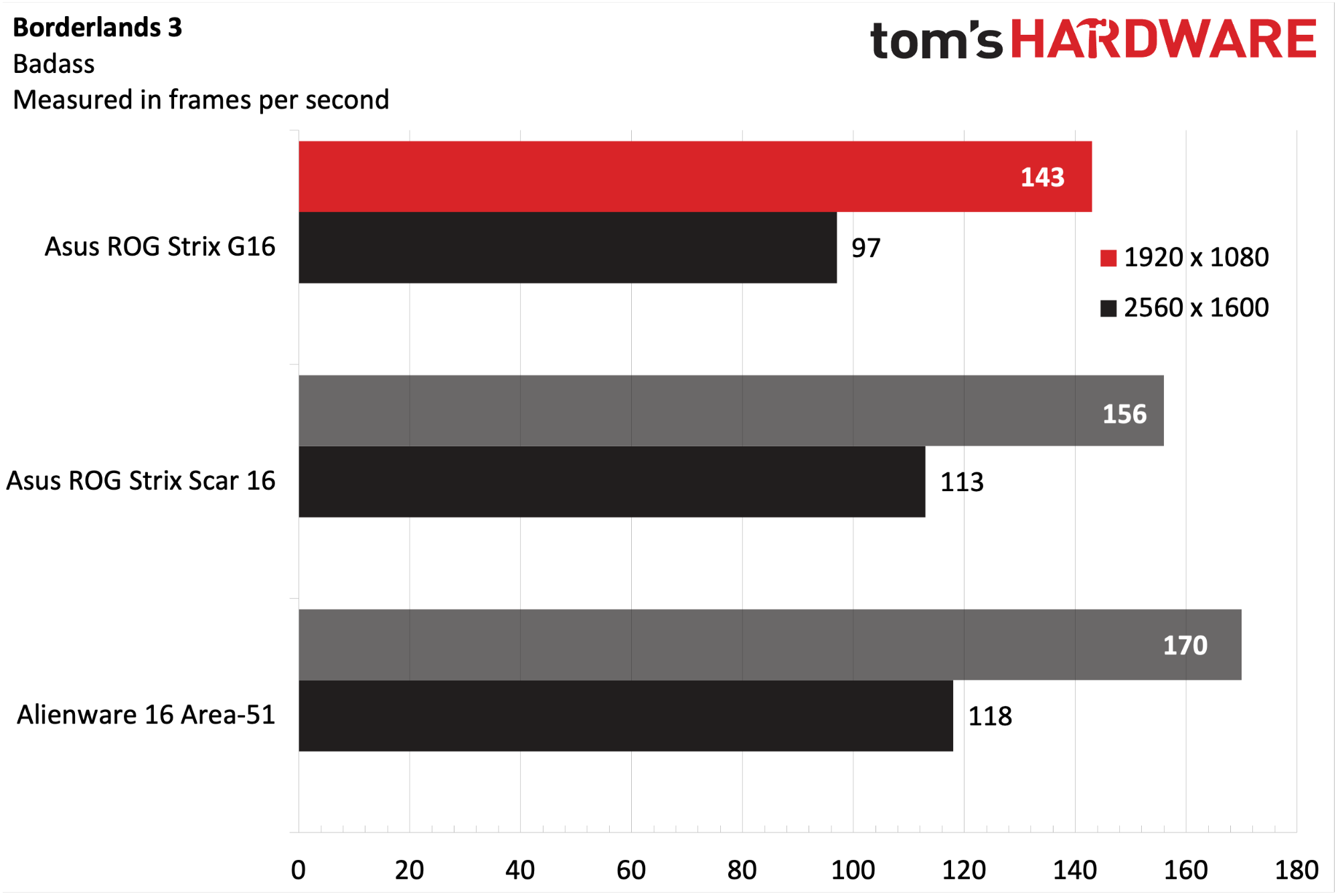
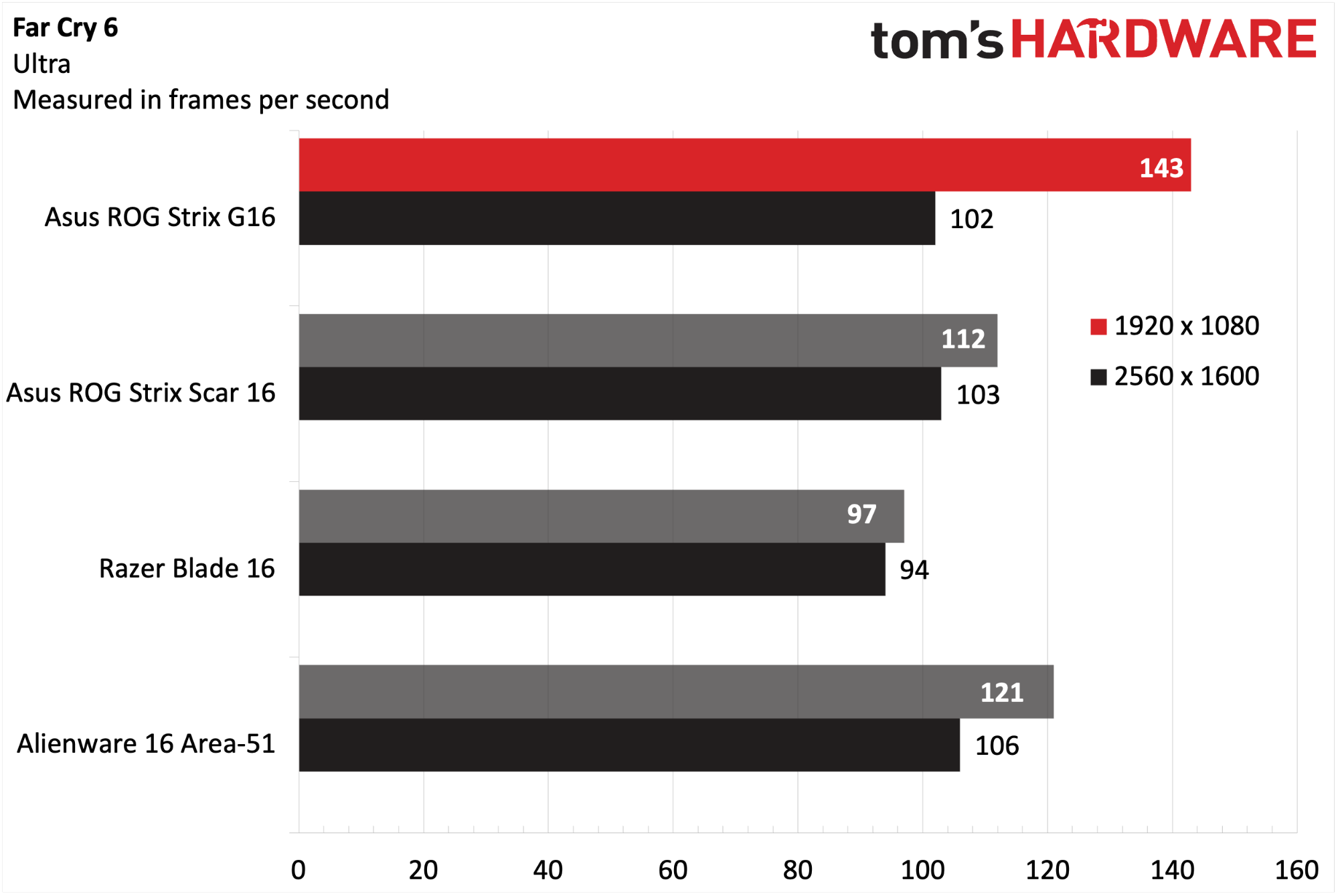
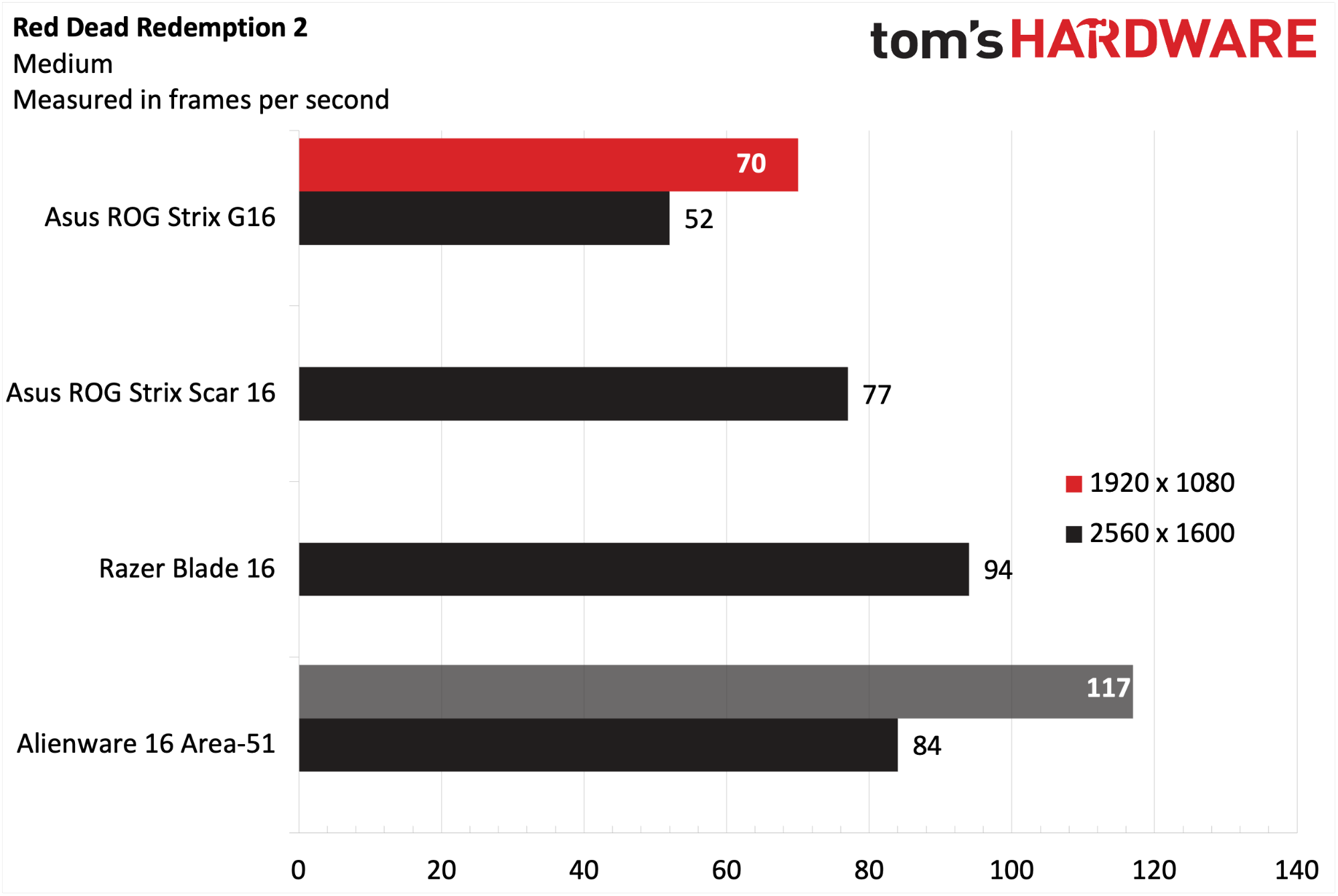
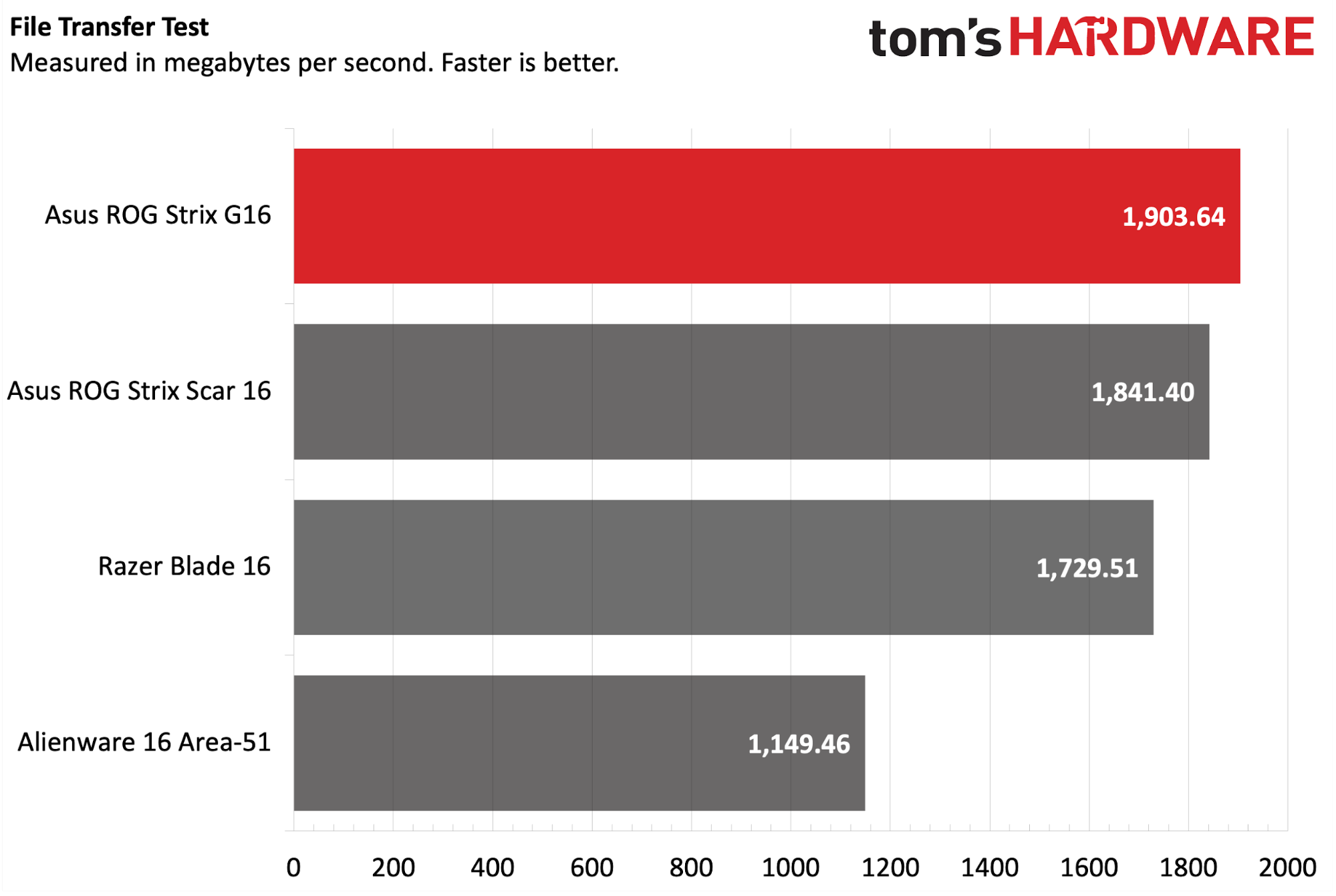
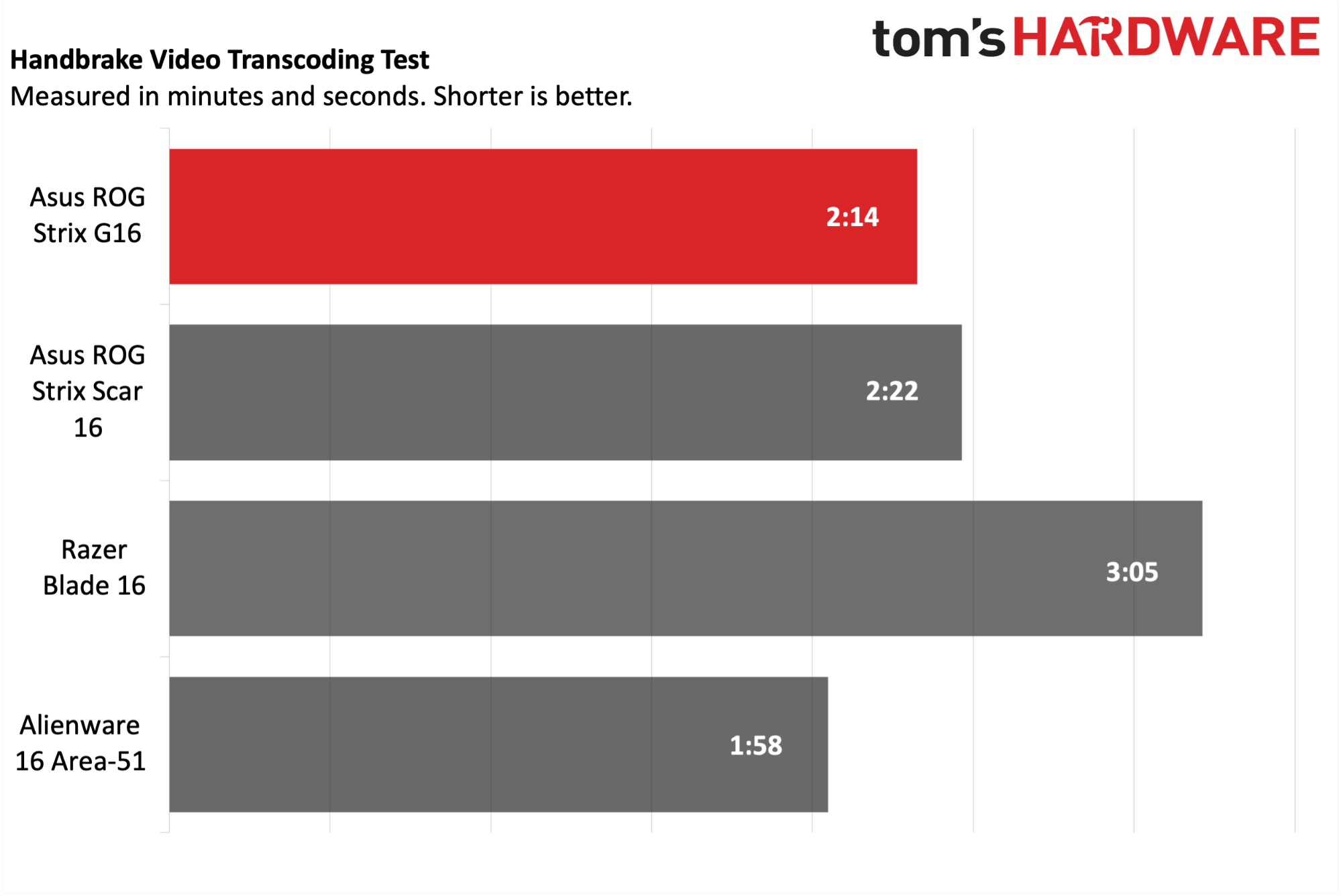
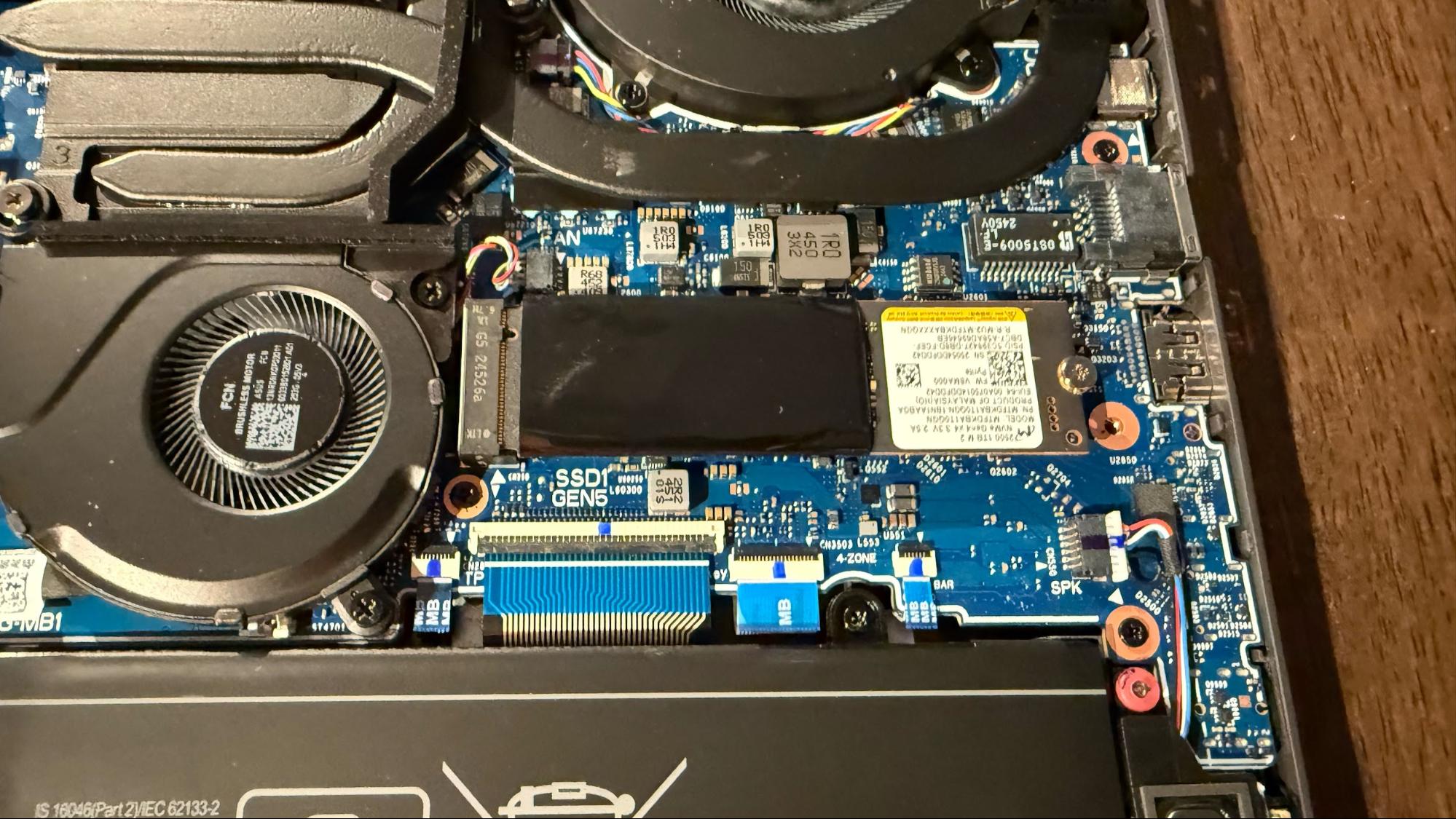
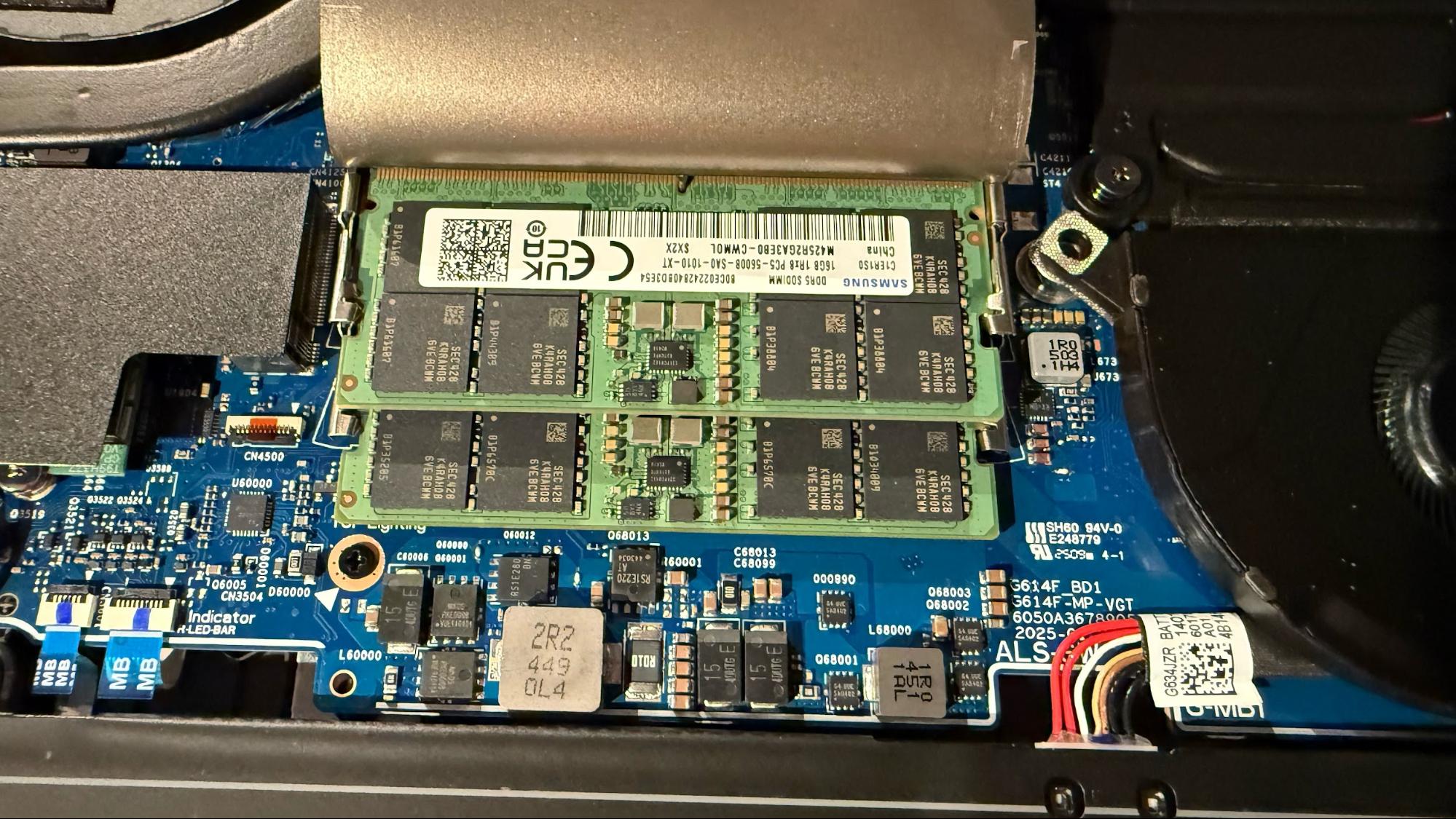
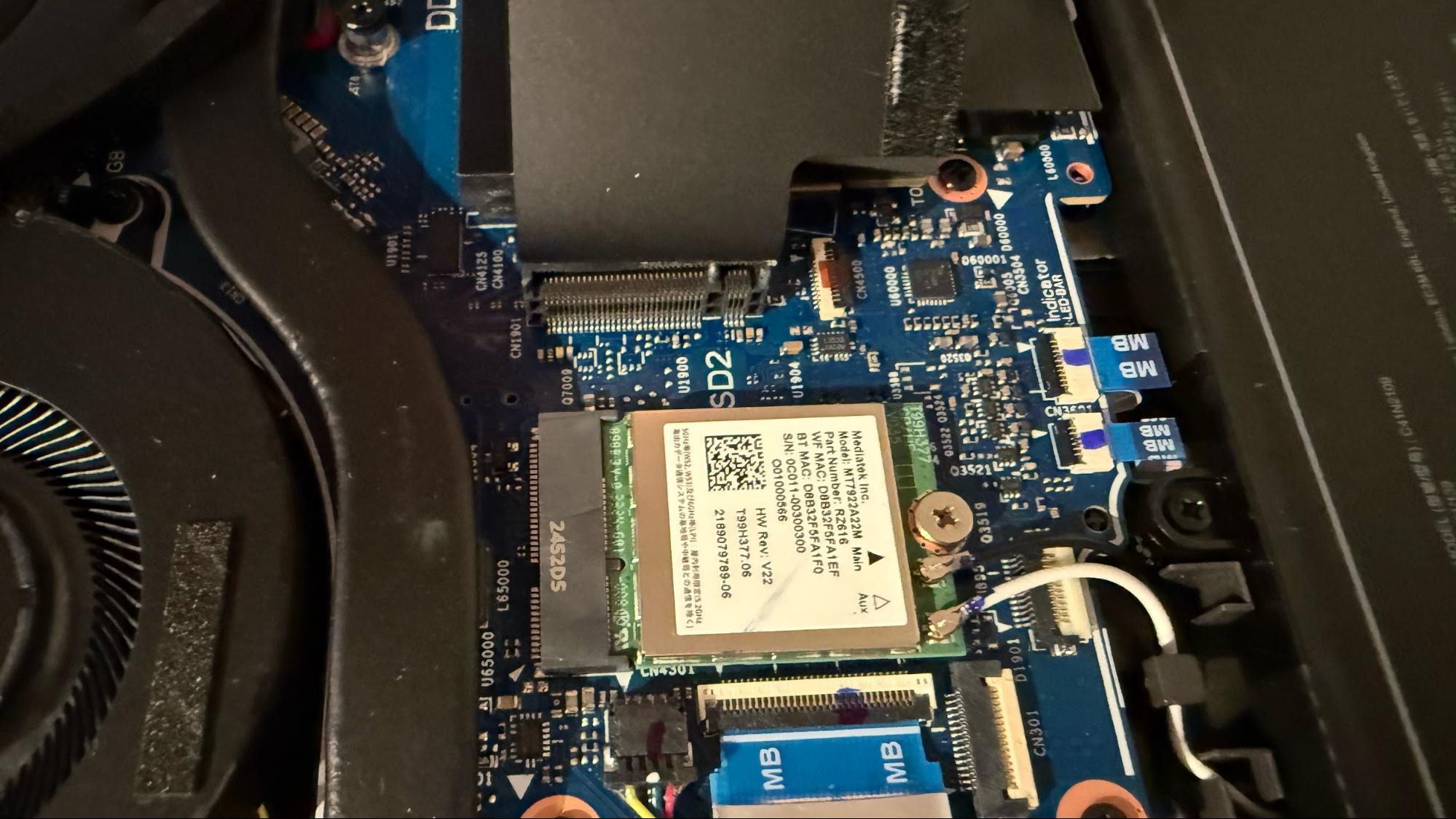







 English (US) ·
English (US) ·